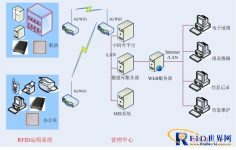
Application of RFID technology in asset management
[ad_1]
introduction:
For some units or institutions that have a large amount of asset management needs, assets have the characteristics of large number, wide distribution, and frequent changes. Asset management currently uses traditional manual management methods and means. Data collection and entry have always been manual operations, and efficiency Low, high error rate, and real-time synchronization of asset physical information and management system information.RFIDAs an emerging information collection technology, through the combination of information transmission and information processing technology, the daily asset management activities can be effectively integrated with the asset management system, so as to achieve real-time synchronization of physical information and system information to achieve instrumentation. The purpose of centralized real-time automatic monitoring and management of instruments, assets and equipment.
system framework:

System functions
1. Basic functions
Asset management includes operations such as the addition, allocation, idleness, scrapping, maintenance, and inventory of assets. It includes the entire process of equipment from leaving the factory and putting it into use to scrapping out of use.
When the equipment is purchased, a dedicated person will add electronic tags to the assets, and the barcode number, name, equipment type, use department, purchase date, price and other information of the asset will be written in the tag, and the asset information will be entered into the central server. The equipment becomes an asset when it is purchased. After it is put into use, there will be normal allocation, maintenance, and scrapping operations. The reader will read the electronic label information on the asset every time it is transferred from the place of use or warehouse. The tag information is transmitted wirelessly (3G/WiFi) to the central server of the background management system to complete the tracking and management of assets.
2. The working principle of the system
The working state of the RFID reader is controlled by the access sensor. When the door is opened, the power amplifier is turned on to communicate with the electronic tag carried by the asset. When an electronic tag enters the identification range and is read, the total number of tags is displayed through sound and light prompts and LED display to inform the staff that the asset information has been identified and sent to the background management system wirelessly.
Each asset is attached with an electronic tag with a unique ID number and corresponding asset-related information. When the asset enters the RFID antenna identification area, the reader obtains the asset-related information, and after confirmation, uploads the asset-related information in real time to RFID system server, the server performs the corresponding format conversion, filtering and related follow-up processing of the data before sending it to the asset management system, as a data source for other system data statistics, query and other functions, to achieve real-time monitoring of changes in the daily asset management, Record and automatic update
System Features
The application system uses the latest international automatic identification technology-radio frequency identification technology (RFID), and uses modern computer technology, wireless transmission technology, automatic control technology and other technologies to comprehensively realize automatic asset identification, informatization and intelligent management.
1. The whole system has the characteristics of long-distance rapid identification, high reliability, high confidentiality, easy operation and easy expansion. The asset identification system can operate independently and does not depend on other systems.
2. Establish safe and reliable registered asset files, strengthen asset supervision through high-tech, rationally allocate resources, reduce resource waste, and prevent asset loss.
3. Research problems from the perspective of professional technology, and effectively solve the chaotic, disorderly, and poor real-time problems in asset management. Provide an advanced, reliable, and applicable digital platform for automatic identification and intelligent management of incoming and outgoing assets, so that the company’s ability to manage internal assets in real time and dynamically is qualitatively improved.
4. Make full use of the RFID automatic collection and GPRS wireless remote transmission functions to achieve real-time consistency between asset change information and system information, and use the SMS alert reminder function to organically integrate daily work with the IT system, and realize that the back-end system Effective real-time monitoring and recording of the work process allows managers to know the allocation and use of assets in the office in a timely manner.
[ad_2]



